|













| |
Last update
09/26/07
|
|
|
|
Most pages in English, Portuguese and some French. Use
Altavista
to translate Help-Search
 Look at the cool pictures
Look at the cool pictures
 |
Where are we going
today? Just click on the city and start your trip! or select the links on the
left side.
Clique no mapa para visitar a área desejada ou clique nas opções à
esquerda.
|

Portuguese navigator Pedro Alvares Cabral
discovered Brazil in 1500. From then on, various export cycles dominated Brazil's economic
development. The first of these cycles was based on the exportation of
brazilwood, used to
make dyes and paints. During the 17th century, Brazil became the world's largest producer
of sugar. In this period, a large number of African slaves were brought to Brazil to work
in the sugar cane plantations. Gold and diamonds eventually replaced sugar as the
country's major export product. By the second half of the 19th century, Brazil was deep in
a new cycle with coffee as the major export. Today, coffee is still one of Brazil's
major sources of income. The late 19th-century rubber boom also brought prosperity and
development to the north of Brazil, previously ignored by the international economy. When
Napoleon invaded Portugal in the early 1800's, Dom
João VI King of Portugal, fled
to Brazil where the Portuguese court continued to run the empire. Ports were opened to
international (mostly British) commerce, and the colony grew substantially. In 1789, one
of Brazil's first movements for independence from Portugal was crushed. Its hero, Tiradentes, became a national symbol of liberty.
Independence was finally proclaimed by Dom Pedro I
(Dom João's son) in 1822. He became Brazil's first Emperor.
His son, Dom Pedro II. reigned for 49 years until 1889 when
the country became a Republic. In 1888, slavery was abolished. In 1940 Brazil began a new
phase characterized by industrial development.
|
At the same time, agricultural technology
advanced giving further impetus to the industrial surge and accelerating financial
expansion. In spite of a large and ever growing internal domestic market. Brazil continues
to be a major exporter of agricultural products as well as manufactured items such as
heavy machinery, shoes and steel products. Other historical
facts

Brazil's inhabitants are descendants of a mixture of
people. Portuguese colonizers mixed with the native Indians and African slaves (mostly of Yoruba and Quimbundu origin,
corresponding to modern-day Nigeria Benin and Angola). Dutch and French colonization also
took place in the Northeast. In the 19th
century, waves of German, Italian, Polish and Japanese
immigrants added new elements to the mixture. Brazilians are perhaps one of the most
racially mixed peoples in the world.
Portuguese is the national language, but
Brazilian Portuguese is very different in accent and intonation from the language spoken
in Portugal or in other former Portuguese colonies. Some people suggest that Brazilians actually speak
''Brazilian" much in the same way that Americans might be said to speak
''American" rather than English.
Need more info about Brazil for your school
report?
(MENTION THIS WEB SITE WHEN YOU WRITE)
NOTE: They have limited jurisdiction including
States of Oregon, Washington, Alaska and
some counties in the state of
California. Visit http://www.brazilsf.org/address.htm for full listing.
Write to:
Setor Cultural
att: Rosana de Sa
Consulate General of Brazil
300 Montgomery St. Suite 900
San Francisco, CA 94104
|
You are the virtual
tourist #
 since
May 2007 since
May 2007
|